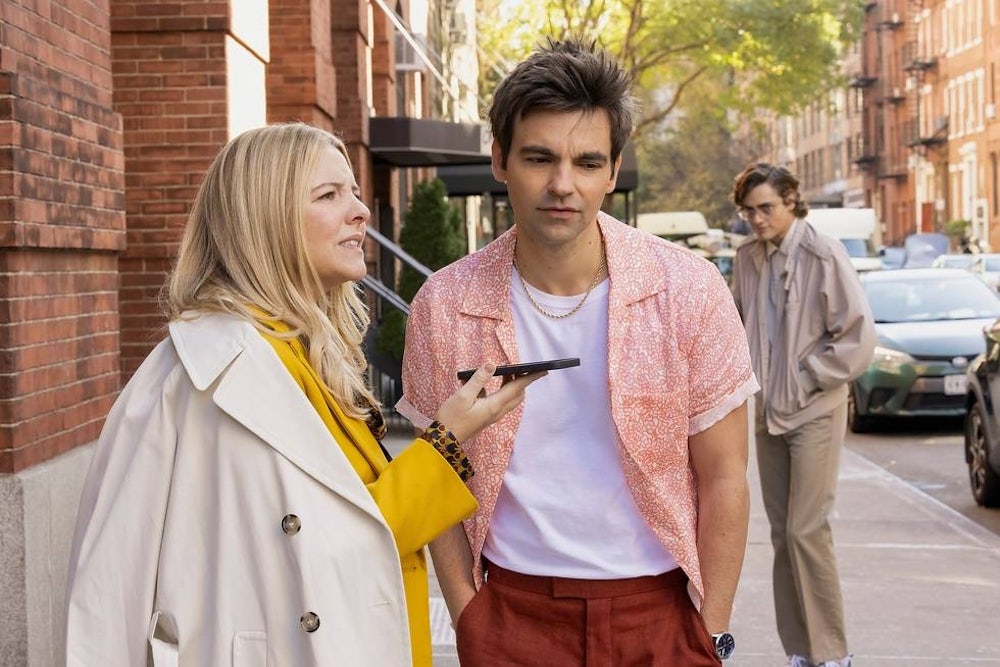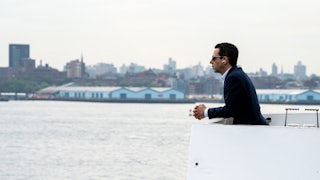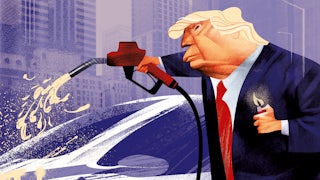The third-season premiere of The Other Two closes on an image of pure loneliness: Cary Dubek’s face illuminated only by the light of his iPhone. This was supposed to be a moment of triumph. Cary (Drew Tarver) is an aspiring actor who’s been struggling to make it for two seasons. At the beginning of the episode, he was finally on the verge of breaking through. He starred in a movie of his own during the pandemic—a ghastly looking VOD drama called Night Nurse, co-starring Edie Falco and Beanie Feldstein—and was about to screen it.
But nothing went to plan. First, the theater that was supposed to host the premiere was sold literally mid-screening and turned into a Starbucks, then his home watch party was foiled because Cary couldn’t remember his Hulu password. Ultimately, Cary settles for voyeurism, watching a neighbor watch the film in the privacy of his living room, as if Norma Desmond were starring in Rear Window. The episode ends with one long, silent shot of Cary alone in bed, scrolling through mentions of Night Nurse on Twitter. It is an anticlimax, not just for the film premiere, but for Cary’s whole career. If this is success, why does it feel so uneventful? For a show that’s frequently about the surreal excesses of celebrity culture, it’s a surprisingly grounded, even relatable moment. A lonely figure, searching for himself online, trying hard not to fall asleep.
In many ways, this is the kind of defeat The Other Two is made of. The show, created by former SNL writers Chris Kelly and Sarah Schneider, revolves around Cary and his sister, Brooke (Heléne Yorke), and their awkward position as a pair of also-rans, the two thirtysomething siblings to a Bieber-esque pop star, who goes by the name Chase Dreams. When their little brother suddenly gets very famous in the show’s 2019 debut, Brooke and Cary enter a world of showbiz cartoons, from the soulless record exec Shuli (Wanda Sykes) to doofus-genius manager Streeter (Ken Marino). Their mom (a career-best Molly Shannon) greets her youngest child’s good fortune with an interminable “say yes” attitude; she, too, gets famous when she rides Chase’s wave and starts her own hit daytime talk show. Cary and Brooke look on with mingled disgust and desire. All of these people are delusional narcissists; oh, to be one of them!
But The Other Two has never just been a send-up of the celebrity-industrial complex. Moments of intimate longing and despair like Cary’s bedtime scroll stand out amid the whirl of fame-hungry antics. Because this is also a show about millennials looking desperately for love and acceptance, the slippage between who we are in private and who we are in public, and the easy satisfaction of always thinking the worst of other people. In other words, The Other Two has always been about social media.
Chase isn’t just a star; he’s a viral star. Part of the reason that Cary and Brooke are caught so off guard by their brother’s meteoric rise is that it happens almost entirely online, with all the speed and ghostliness the internet provides. His fame feels unreal, almost theoretical. There are no album signings, no live shows, and Chase—as we eventually learn—can’t even sing. There’s just a viral video called “Marry U at Recess,” an unholy number of “likes,” and a whole lot of money pouring in.
But that’s just where it starts. Social media is the lens for a lot of the show’s biggest bits and even plotlines. It is, just as in life, omnipresent, and so, even as the show spotlights the inherent ridiculousness of the extremely online, it also understands the way social media is a deranging accelerant of everyday problems, and thus a medium of everyday life. Brooke befriends an Instagram cosmetics influencer, not realizing that she’s only 11 years old, because her makeup is so thick and garish. Chase’s second single, “My Brother’s Gay,” draws unwelcome attention to Cary, but, after Countess Luann from Real Housewives posts an emotional response to the video, Shuli informs Cary that’s he’s officially become “camp,” and a colleague pops champagne: Chase will “live on forever in the gay community … as a joke.” There’s a band of recurring characters called “The Instagays,” who reappear every season, having wholly reinvented their personalities—they go to pool parties, they flip houses, they pose in Speedos in a church—to optimize engagement on their influencer accounts. Shuli tries to send Chase’s ex-girlfriend to an off-the-grid compound in the wilderness to prevent her from being doxed by Chase’s fans. Cary records a video for somebody on Cameo and then awkwardly crashes their birthday party; he uses Grindr to determine the ethical ramifications of joining a homophobic church for clout; he gets into a Twitter firestorm when he voices the first openly gay character in a Disney film; his publicist stages an intervention because he’s posting about his movie too much.
These are all just a bunch of funny jokes about people who are too online, celebrities whose shallow fame exists only by way of the apps, and a contemporary American culture hypnotized by the blue light of screens. But each of these incidents also reveals a little of the deeper personalities these fragile people try to transform or express or hide. The “My Brother’s Gay” saga addresses Cary’s discomfort with expressing his sexuality in public, which goes back to the painful memory of his recently deceased father’s disapproval. Brooke’s desperation to be seen leads her to become blind to her tween friend’s true identity. Everybody, everybody is so, so lonely.
In her book The Drama of Celebrity, the scholar Sharon Marcus argues that celebrity, as we know it, is a cultural phenomenon with three distinct authors. There’s the celebrity, who expresses themself through whatever art or product they make; there are the journalists who write about and photograph and criticize and otherwise construct the celebrity’s public image; and then there’s the public, who contribute devotion and imagination, and money, and love and hate. For Marcus, no single one of these authors does it alone. The star begins to burn at the convergence point between those three forces.
In this framework, social media is the perfect cauldron for the witches’ brew of celebrity. But it also allows ordinary people, civilians, to experience some boutique version of the dissociation and detachment from reality that’s long been the most famous side effect of fame. There was a time when Marilyn Monroe emerged as an illusion, a trick of the light produced between herself, her studio’s massive press apparatus, and an adoring and vampiric public. Today, anyone can be an illusion like this, if at smaller scale.
The Other Two really understands this parallel. Its screen time obsession isn’t just a layer of timely jokes about millennial distraction and vacuousness. Social media is the way that this show about big, dumb stars becomes a show about ordinary, dumb people. The show both mirrors and skewers the grotesqueries of online life. It “dunks” on its characters, scoring points off of their vulnerabilities in a way that should seem familiar to Twitter users: Streeter revealing his Sublime-style belly button tattoo is somehow both hilarious and depressing. The show reproduces the toxicity that’s become the hallmark of social media, but then it also works, bit by bit, to counteract it.
In this new season, for instance, Brooke’s arc revolves around her ambivalence about celebrity and the pressure of pandemic-era social-media virtue signaling. Over the course of the show, she becomes Chase’s co-manager. She loves it, but she also understands that the industry she works in is callow and exploitative. During the pandemic, she watches seemingly all her friends and acquaintances rededicate themselves to “doing good”—while posting about it constantly, of course—as she burrows further and further into her work in the belly of the beast. And so, despite achieving her own showbiz dreams, she’s once again left feeling like everybody’s moved on without her.
But just because Brooke and Cary see themselves as the center of the universe, that doesn’t mean the show agrees. While The Other Two is always scorched-earth with its satirical targets, and its portrait of the industry is astringently unflattering—in one episode, industry people literally can’t see or hear nonindustry guests at a party—it never really gives up on anybody. Indeed, one of the show’s greatest strengths is its commitment to fleshing out and taking seriously its side-characters. No one is a better example of this than Brooke’s on-again, off-again boyfriend, fan favorite Lance (Josh Segarra).
In the first season, Lance is Brooke’s loser boyfriend, who is always pitching harebrained ideas for custom sneakers. He’s the type of guy—earnest, guileless, not self-aware—who makes an easy target for mockery, online or off. Over the course of the first two seasons, though, the show starts to train its gaze on Lance’s relentless, unflappable positivity. What began as a joke became a curiosity, and, slowly—with the help of Segarra’s on-screen magnetism and puppylike physical expressivity—Lance has become something like the show’s moral center.
This season, Brooke is at odds with Lance because his seeming goodness—he quit the world of high fashion to become a nurse during the pandemic—makes her feel bad about her own choices. When this simmering conflict comes to a head, Segarra delivers a showstopping monologue. He manages, somehow, to hold on to the daft eccentricity that makes his character such a comedic high point of the show, while absolutely ripping that character’s chest open. It’s a baffling feat for this character to essentially rage, on-screen, about the idea that anyone ever thought he was just there for comic relief.
Again and again the audience is denied the pleasure of simple mockery. Cary’s love interest this season is a buzzy young actor who stays in character 24 hours a day for his roles. It’s a clever little dig against method acting, but the show holds the bit long enough for the joke to end up on Cary. Sure, this guy’s being ridiculous, but Cary’s the one who’s decided to be in a long-term relationship with a man he’s never really met. The show by no means wants to redeem the industry, but, this season especially, it’s become invested in exposing the lazy nihilism that can come along with seeing the worst in people. If you run into a craven, soulless industry hack in the morning, you ran into a craven, soulless industry hack; if you run into them all day, you are the craven, soulless industry hack.
Ultimately, just like social media, and just like celebrity, The Other Two is about identity. It’s a flimsy, fungible thing, and it’s a trap. It’s a point of pride and a point of embarrassment. There’s the real you that we all struggle to find and to express truthfully; there’s the version of yourself that you perform for the public; there’s the version of you that others create in and against their own image. This is true for Kim Kardashian, it’s true for Chase Dreams, it’s true for Cary and Brooke Dubek, and for you and for me. This extremely funny, surprisingly moving show understands that truth. There’s you, and then there’s the other two.






